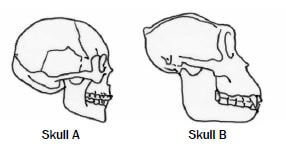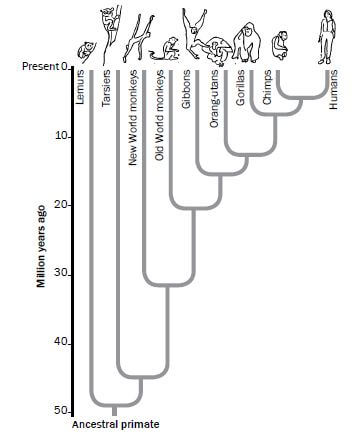EVOLUTION - LIFE SCIENCES QUESTIONS AND ANSWERS
Share via Whatsapp Join our WhatsApp Group Join our Telegram GroupActivity 1
Questions
- Write an account showing how Lamarck would have explained the development of longer necks in modern giraffes. (5)
- Write an account showing how Darwin would have explained the development of longer necks in modern giraffes. (7)
- Explain why Lamarck’s theory was rejected. (2) [14]
Answers to activity 1
1.
- All giraffes had short necks✔ originally.
- These giraffes frequently stretched✔their necks.
- They did this to reach the leaves that were available only higher up on the trees.✔
- As a result, their necks became longer.✔
- The characteristic of long necks acquired in this way was then passed on to the next generation.✔
- Eventually all the giraffes had longer necks.✔ (5)
2.
- As a result of genetic variation✔ in the giraffe population some giraffe had longer necks than others.✔
- As a result of leaves being available only higher up on trees,✔ giraffes competed for these leaves.
- Giraffes with shorter necks died.✔
- Giraffes with longer necks survived.✔
- This is natural selection.✔
- The allele ✔ for longer necks was passed on to subsequent generations.✔
- Eventually all the giraffes had longer necks.✔ (7)
3. There is no evidence ✔ to show that acquired characteristics are inherited ✔/There is no evidence that structures used more frequently become more developed or vice versa (2) [14]
Activity 2
1. Use the information in Figure 10.3 below to explain how a new species of rabbit has arisen because of a geographical barrier. [9]
Figure 10.3 Speciation in a rabbit population
2. The diagram below represents the changes in a population of bacteria over time as a result of exposure to an antibiotic over time.
Figure 10.4. Development of antibiotic resistance in a bacteria population
Explain, in terms of natural selection, the shift in the resistance level of the bacteria illustrated above. [8]
Answer to activity 2
-
- A population of rabbits become split✔ by a geographical barrier/river✔
- As a result, the two parts of the population cannot interbreed.✔
- There is no gene flow✔ between the two populations.
- Natural selection occurs independently✔ in each population due to different environmental conditions✔ on either side of the river.
- As a result, the two populations become genotypically and phenotypically different✔over a period of time.
- Even if the geographical barrier is removed (ie the river returns to its normal course at some later time), the rabbits will not be able to interbreed again.✔
- We say that one or both parts of the rabbit population have become a new species✔. [9]
- There is a large degree of variation in the bacteria population✔
- When the antibiotic was first used, it killed off a large number of bacteria✔
- But some bacteria were resistant to the antibiotic✔ and survived✔
- Those that survived were able to reproduce✔
- Increasing the population of resistant bacteria✔
- Continued use of the antibiotic had little effect on the resistant bacteria✔
- Hence the resistant bacteria increased✔
- And non-resistant bacteria decreased✔ [8]
Activity 3
Question 1
Study the two skulls shown in Figure 10.8 below and answer the questions that follow.
Figure 10.8 Skull diagrams of two organisms
1.1 Which skull (A or B) is that of a non-human primate? (1)
1.2 List FIVE OBSERVABLE reasons (based only on features that are visible in the diagram) for your answer in question 1.1. (5) [6]
Answers to question 1
1.1 Skull B✔ (1)
1.2
- Pronounced brow ridge✔
- Protruding jaw/prognathous✔
- Large canine✔
- Small cranium✔
- Cranial ridge across the top of the cranium✔ (5) [6]
Question 2
The diagrams in Figure 10.9 below represent the skulls of three organisms:
Taung child (Australopithecus africanus), a modern human (Homo sapiens) and a gorilla (Gorilla gorilla). The arrow indicates the position of the foramen magnum (the opening that allows the spinal cord to connect with the brain). Study the diagrams and answer the questions that follow:
Figure 10.9 Skull diagrams showing the position of the foramen magnum
2.1 Identify the organisms that are represented by each of skulls A, B and C. (3)
2.2 Assuming that the diagrams were drawn to scale, list THREE observable differences between the skulls of organisms A and B. (6)
2.3 By looking at the position of the foramen magnum (indicated by the arrows), state which TWO organisms are best adapted for walking on two legs rather than four legs. (2)
2.4 Explain, using observable features, why the organism to which skull C belongs can be regarded as a transitional species (a species that is in the process of changing). (3) [14]
Answers to question 2
2.1
- - Homo sapiens/human✔
- - Gorilla gorilla/gorilla✔
- - Australopithecus africanus (Taung child)✔ (3)
2.2
| Skull A | Skull B |
| Brow ridge reduced/absent✔ | Pronounced brow ridge✔ |
Non-prognathous/non-protruding jaw✔ | Prognathous/protruding jaw✔ |
Poorly developed canines✔ | Large canines✔ |
No cranial ridges✔ | Cranial ridges present✔ |
Large cranium✔ | Small cranium✔ |
(any 3 × 2) (6)
2.3 Homo sapiens/huma✔ AND Australopithecus africanus (Taung child)✔ (2)
2.4 It has features of the skull that are intermediate✔ between that of skulls A and B, e.g. jaw protrudes more than in skull A but less than in skull B✔, face not flat in skull of B but flat in skull A. (3) [14]
Activity 4
- What general observation can you make about the characteristics as one moves from the earlier to the later organisms listed in the table? (2)
- Use information in the table to describe the specific evolutionary trend (how each of the features changed over time) relating to each of the following characteristics:
2.1 Brain size
2.2 Position of foramen magnum
2.3 Prognathous jaws
2.4 Dentition
2.5 Development of brow ridges 5 × 2 (10) - State the significance of the changes that occurred as they apply to each of the following characteristics:
3.1 Brain size
3.2 Position of foramen magnum
3.3 Prognathous jaws
3.4 Dentition
3.5 Development of brow ridges 5 × 2 (10) - Explain how the information in the table provides evidence for the ‘Out of Africa’ hypothesis. (2) [24]
Answers to activity 4
1. There is a gradual change in the characteristics✔ over a period of time. ✔ (2)
2. 2.1 Brain size: Increase✔ in brain size✔
2.2 Position of foramen magnum: Movement to a more✔ forward position✔
2.3 Prognathous jaws: Change from more prognathous✔ to less prognathous✔
2.4 Dentition: Decrease in the size✔ of the teeth✔ OR decrease✔ in the size✔ of the canines
2.5 Development of brow ridges: Brow ridges become less✔ developed✔ 5 × 2 (10)
3. 3.1 Brain size: Increased brain size allows for processing information more quickly ✔and for processing a larger amount of information. ✔
3.2 Position of foramen magnum: More forward position of the foramen magnum✔ indicates bipedalism. ✔ A decrease in the length of the arms indicates a decreased dependency on its use in locomotion and therefore shows a more advanced stage of bipedalism. This is usually accompanied by an increase in the length of the legs.
3.3 Prognathous jaws: A less prognathous jaw indicates a smaller jaw. ✔ A small jaw is sufficient since there was a change from eating raw food to eating cooked food. ✔
3.4 Dentition: The change from large to smaller teeth✔was due to the change in diet from raw food to cooked food✔
3.5 Development of brow ridges: Brow ridges became less developed since the action of the smaller jaws✔did not create forces great enough for the skull to have increased strength from the brow ridges✔ 5 × 2 (10)
4. The information in the table shows that fossils of the different organisms that are considered to have existed in the same line as humans✔ were all found in Africa. ✔ (2) [24]
Activity 5
Study the phylogenetic tree in Figure 10.11 below and answer the questions based on it.
Questions
- How long ago did the ancestral primate live on earth?(2)
- Name the organism that shares the most distant common ancestor with humans.(1)
- Name the organism that is most closely related to humans. (1)
- How many years ago did the New World monkeys split from the common ancestor that gave rise to the Old World monkeys? (2)
- For how long did the common ancestor that evolved into the gibbons exist? Show your working. (3)
- Humans and gorillas share many common characteristics with primates. List THREE of these common characteristics. (3)[12]
Answers to activity 5
- 50✔ million years ago✔/mya (2)
- Lemurs✔ (1)
- Chimpanzee✔ (1)
- 33✔ million years ago✔/mya (2)
- 22 million years - 15 million years✔ = 7✔million years✔ (3)
-
- Large brain✔
- Eyes in front✔
- Freely rotating arms✔
- Long upper arms✔
- Rotation around elbow joints✔
- Bare fingertips or nails instead of claws✔
- Opposable thumb✔
- Upright posture✔ (any 3) (3) [12]
Activity 6
Question 1
Give the correct biological term for each of the following descriptions. Write only the term next to the question number (1.1 to 1.17).
1.1 The development of new species from existing species.
1.2 A study of the distribution of organisms in different parts of the world.
1.3 Similar structures in different organisms indicating common ancestry.
1.4 Having a pointed face because of projecting jaws and nose.
1.5 A group of similar organisms that can breed to produce fertile offspring.
1.6 A group of organisms of the same species that occupy a particular habitat.
1.7 Only organisms with favourable characteristics survive.
1.8 Using parents with particular desirable characteristics to obtain a combination of these desirable characteristics in the offspring
1.9 An opening in the skull through which the spinal cord passes
1.10 Locomotion involving the use of a pair of hind limbs only
1.11 Mechanisms that prevent different species from reproducing with each other
1.12 The study of fossils which provides evidence for evolution
1.13 Sudden change to the genetic composition of an organism
1.14 Branched diagram showing evolutionary relationships among organisms
1.15 Remains of organisms that have existed in the past
1.16 Genus to which Little Foot, Mrs Ples, Karabo and the Taung Child belong
1.17 Genotypic and phenotypic differences among organisms of the same species [17]
Answers to activity 6
1.1 Speciation✔
1.2 Biogeography✔
1.3 Homologous✔
1.4 Prognathous✔
1.5 Species✔
1.6 Population✔
1.7 Natural selection✔
1.8 Artificial selection✔
1.9 Foramen magnum✔
1.10 Bipedal✔
1.11 Reproductive isolation✔
1.12 Paleontology✔
1.13 Mutation✔
1.14 Phylogenetic tree✔
1.15 Fossils✔
1.16 Australopithecus✔
1.17 Variation✔ [17]